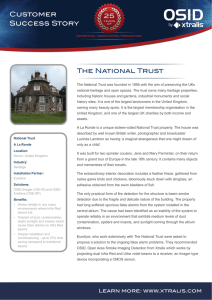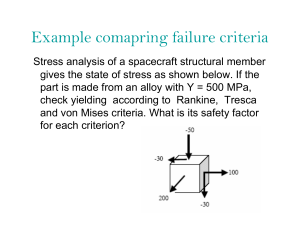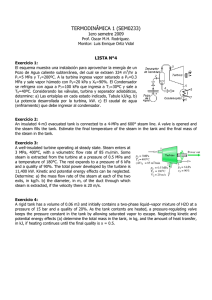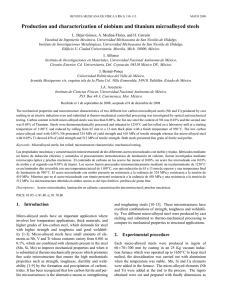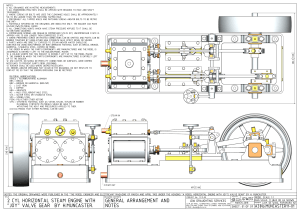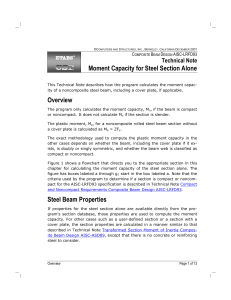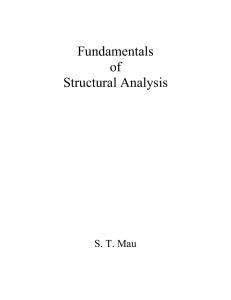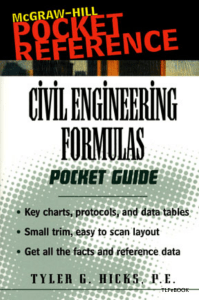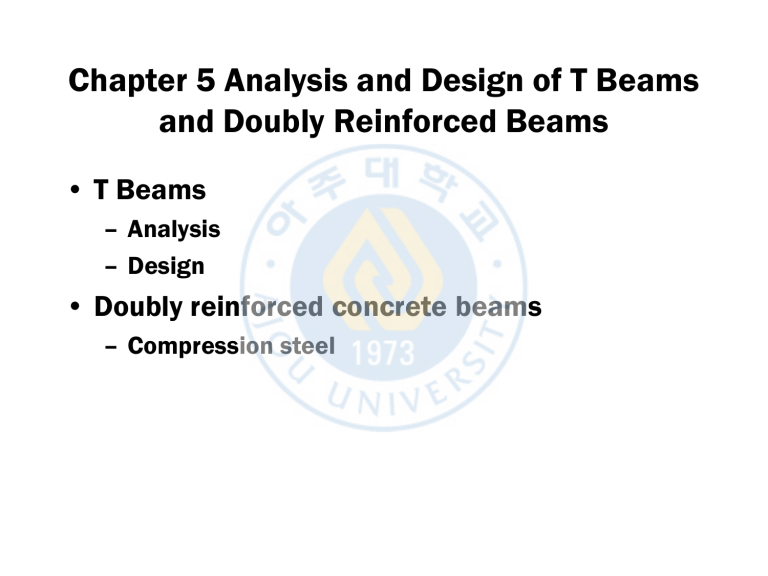
Chapter 5 Analysis and Design of T Beams and Doubly Reinforced Beams • T Beams – Analysis – Design • Doubly reinforced concrete beams – Compression steel T Beams • Monolithically constructed floor system resulting in T-shaped beams (or L-shaped beams) • Consists of flange and web • Effective only when the flange is subjected to flexural compression S1 S2 Effective Flange Width • For T-shaped beams, lesser of – L/4 – bw+2×8hf – bw+(S1+S2)/2 • For L-shaped beams, lesser of – L/12 – bw+6hf – bw+S/2 S1 S2 Isolated T Beams 8.10.4 ― Isolated beams, in which the T-shape is used to provide a flange for additional compression area, shall have a flange thickness not less than one-half the width of web and an effective flange width not more than four times the width of web. ACI 318M-05 Location of neutral axis determines whether the rectangular beam formulas apply Rectangular beam formulas can be applied Rectangular beam formulas cannot be applied Analysis of T Beams • Check As,min as per ACI Section 10.5.1 using bw as the web width • Compute T=Asfy • Determine Ac stressed to 0.85f'c T Ac = 0.85 f c′ • Calculate a, c, εt • Calculate φMn Example 5.1 Determine the design strength of the T beam shown below with f'c=27.6 MPa and fy=414 MPa. b=1524 mm hf=100 d=610 mm 6-#29 (As=3870 mm2) bw=254 mm Minimum reinforcement: As ,min = (ACI 318M-05 10.5.1) As ,min = f c′ 27.6 bw d = × 254 × 610 = 491.5 mm 2 4 fy 4 × 414 1.4bw d 1.4 × 254 × 610 = = 524 mm 2 ← fy 414 As , provided > As ,min O.K . Example 5.1 Determine the design strength of the T beam shown below with f'c=27.6 MPa and b=1524 mm fy=414 MPa. hf=100 d=610 mm 6-#29 (As=3870 mm2) Assuming steel yielding, Ac = bw=254 mm T 3870 × 414 = = 68294.1 mm 2 0.85 f c′ 0.85 × 27.6 a= Ac 68294.1 a 44.8 = = 44.8 mm → c = = = 52.7 mm (neutral axis within the slab) b 1524 β1 0.85 εt = 0.003 (d − c ) = 0.003 × (610 − 52.7 ) = 0.0317 > 0.005 → φ = 0.9 c 52.7 Design strength: φM n = φAs f y (d − a 2 ) = 0.9 × 3871× 414 × (610 − 44.8 2 )×10 −6 = 847.5 kN − m Method for Analyzing T Beams When a>hf, slab contribution to compression can be divided into web portion and flange portion. Cw = 0.85 f c′abw C f = 0.85 f c′(b − bw )h f M n = Cw (d − a 2 ) + C f (d − h f 2 ) Example 5.2 Compute the design strength for the T beam shown below in which f'c=27.6 MPa and fy=414 MPa b=762 mm hf=102 mm Minimum reinforcement: As ,min = f c′ 27.6 bw d = × 254 × 610 = 491.5 mm 2 4 fy 4 × 414 1.4bw d 1.4 × 356 × 762 d=762 mm As ,min = = = 917.3 mm 2 ← 660 mm 414 fy 8-#32 As=6552 mm2 As , provided > As ,min O.K . Assuming steel yielding: bw=356 mm Ac = a= T 6552 × 414 = = 115623.5 mm 2 0.85 f c′ 0.85 × 27.6 Ac 115623.5 = = 151.7 mm > h f b 762 → neutral axis is located out of slab Example 5.2 Compute the design strength for the T beam shown below in which f'c=27.6 MPa and fy=414 MPa Calculation of stress block depth: As f y − 0.85 f c′h f (b − bw ) a= 0.85 f c′bw b=762 mm hf=102 mm 6552 × 414 − 0.85 × 27.6 ×102 × (762 − 356 ) 0.85 × 27.6 × 356 = 208.5 mm a 208.5 = = 245.2 mm c= β1 0.85 = d=762 mm As=6552 mm2 bw=356 mm εt = 0.003 (d − c ) = 0.003 (762 − 245.2) = 0.0063 > 0.005 → φ = 0.9 c 245.2 Design strength: φM n = φ 0.85 f c′[abw (d − a 2 ) + h f (b − bw )(d − h f 2 )] = 0.9 × 0.85 × 27.6 × [208.5 × 356 × (762 − 208.5 2 ) + 102 × (762 − 356 )(762 − 102 2 )]×10 −6 = 1652.5 kN − m Design of T Beams • Follow the procedure similar to the design of rectangular beams Example 5.4 Design a T Beam for the floor system shown below for which bw and d are given. MD=108.5 kN-m, ML=135.6 kN-m, f'c=27.6 MPa, fy=414 MPa and simple 100 mm span=6.1 m d=457 mm 305 mm 3048 mm 3048 mm 3048 mm 3048 mm Effective flange width: b = L 4 = 6100 4 = 1525 mm ← smallest b = bw + 2 × 8h f = 305 + 16 ×100 = 1905 mm b = bw + (S1 + S 2 ) 2 = 3048 mm Factored moment: M u = 1.2 M D + 1.6 M L = 1.2 ×108.5 + 1.6 ×135.6 = 347.2 kN − m Assuming steel yielding and φ=0.9, jd=0.9d, Mu 347.2 ×106 = = 2265.6 mm 2 As ,required = φf y jd 0.9 × 414 × 0.9 × 457 → Use 4-#25 (As,provided=2040 mm2) Beam width: bw = 2×40+2×10+4×25+3S = 305 mm → S = 35mm > 25mm O.K. Example 5.4 Design a T Beam for the floor system shown below for which bw and d are given . MD=108.5 kN-m, ML=135.6 kN-m, f'c=27.6 MPa, fy=414 MPa and simple 100 mm span=6.1 m d=457 mm 305 mm 3048 mm 3048 mm As ,min = f c′ bw d 4 fy 3048 mm As ,min = 1.4bw d fy 3048 mm As ,max = 0.0181bw d = 0.0181× 305 × 457 1.4 × 305 × 457 27.6 = 2522.9 mm 2 > As , provided = × 305 × 457 414 4 × 414 = 471.4 mm 2 < As , provided = 442.2 mm 2 < As , provided As f y a 24.4 2040 × 414 a= = = 24.4 mm < h f → c = = = 28.7 mm → φ = 0.9 β1 0.85 0.85 f c′b 0.85 × 26.7 ×1525 = φM n = φAs f y (d − a 2) = 0.9 × 2040 × 414 × (457 − 24.4 2 )×10 −6 = 338 kN − m ≈ M u (2.7% under, say O.K.) Example 5.5 Design T beam for the floor system below for which bw and d are given MD=271.3 kN-m, ML=576.5 kN-m, f'c=20.7 MPa, fy=414 MPa, and sipmle span=5.5 m 76 533 mm 381 1829 mm 381 1829 mm 381 1829 mm 1829 mm Effective flange width: b = L 4 = 5500 4 = 1375 mm ← smallest b = bw + 2 × 8h f = 381 + 16 × 76 = 1597 mm b = bw + (S1 + S 2 ) 2 = 1829 mm Factored moment: M u = 1.2M D + 1.6M L = 1.2 × 271.3 + 1.6 × 576.5 = 1248 kN − m 610 Example 5.5 Design T beam for the floor system below for which bw and d are given MD=271.3 kN-m, ML=576.5 kN-m, f'c=20.7 MPa, fy=414 MPa, and sipmle span=5.5 m 76 533 mm 381 1829 mm 381 1829 mm 610 381 1829 mm 1829 mm Assuming steel yielding and φ=0.9, jd=0.9d, Mu 1248 ×106 = = 6101 mm 2 As ,required = φ f y jd 0.9 × 414 × 0.9 × 610 double layer → Use 10-#29 double layer (As,provided=6450 mm2) Beam width: bw = 2×40+2×10+5×29+4S = 381 mm → S = 34mm > 25mm O.K. Example 5.5 Design T beam for the floor system below for which bw and d are given MD=271.3 kN-m, ML=576.5 kN-m, f'c=20.7 MPa, fy=414 MPa, and sipmle span=5.5 m 76 533 mm 381 381 381 f c′ 20.7 bw d = × 381× 610 = 638.5 mm 2 < (As , provided )mod ified 18294mm 1829 mm fy 4 × 414 1829 mm As ,min = As ,min = 1829 mm 1.4bw d 1.4 × 381× 610 = = 786 mm 2 < (As , provided )mod ified fy 414 As ,max = 0.0135bw d = 0.0135 × 381× 610 = 3138 mm 2 < As , provided (A 610 ) s , provided mod ified N .G. = As , provided − 0.85( f c′ f y )h f (b − bw ) = 6450 − 0.85 × (20.7 414 )× 76 × (1375 − 381) = 3239 mm 2 Since still (As , provided )mod ified > As ,max , slab thickness should be increased. Let' s use h f = 80 mm Example 5.5 Design T beam for the floor system below for which bw and d are given MD=271.3 kN-m, ML=576.5 kN-m, f'c=20.7 MPa, fy=414 MPa, and sipmle span=5.5 m 80 533 mm 381 1829 mm (A ) s , provided mod ified 381 1829 mm 381 1829 mm 1829 mm = As , provided − 0.85( f c′ f y )h f (b − bw ) = 6450 − 0.85 × (20.7 414)× 80 × (1375 − 381) = 3070 mm 2 As ,max = 0.0135bw d = 0.0135 × 381× 610 = 3138 mm 2 > (As , provided )mod ified O.K . 6450 × 414 a 110.4 = 110.4 mm > h f → c = = = 129.9 mm 0.85 f c′b 0.85 × 20.7 ×1375 β1 0.85 Since the neutral axis is located out of flange, take the secton into web and flange parts! a= As f y 610 = Example 5.5 Design T beam for the floor system below for which bw and d are given MD=271.3 kN-m, ML=576.5 kN-m, f'c=20.7 MPa, fy=414 MPa, and sipmle span=5.5 m 80 533 mm 381 1829 mm 381 1829 mm 610 381 1829 mm 1829 mm As f y a 189.6 6450 × 414 − 0.85 × 20.7 × (1375 − 381)× 80 = = 189.6 mm → c = = = 223.1 mm ′ β1 0.85 0.85 f c bw 0.85 × 20.7 × 381 0.003 (d − c ) = 0.003 (610 − 223.1) = 0.0052 > 0.005 → φ = 0.9 εt = c 223.1 a= Example 5.5 Design T beam for the floor system below for which bw and d are given MD=271.3 kN-m, ML=576.5 kN-m, f'c=20.7 MPa, fy=414 MPa, and sipmle span=5.5 m 80 533 mm 381 1829 mm 381 1829 mm 381 1829 mm 1829 mm φM n = φ [C f (d − h f 2) + Cw (d − a 2)] = 0.9 × [0.85 f c′(b − bw )h f (d − h f 2 ) + 0.85 f c′abw (d − a 2 )] = 0.9 × 0.85 × 20.7 × (1375 − 381)× 80 × (610 − 80 2 )×10 −6 + 0.9 × 0.85 × 20.7 ×189.6 × 381× (610 − 189.6 2 )×10 −6 = 1307.1 kN − m > M u 610 Design of T Beams for Negative Moments • Part of beams under negative moment causing the convex shape of beam deflection • In this case, flanges in tension and lower part of web in compression • No beneficial effect from flange concrete cannot be expected • Therefore, beams in this category are rather the rectangular beam than the T beam tension T compression C Compression Steel • Results in doubly reinforced concrete beams – Different from the double layered steel • Increases moment capacity by increasing tension steel without violating the maximum steel limit • Makes the beam ductile and tough to be earthquake resistant • Reduces long-term deflection due to shrinkage and plastic flow • Makes the fabrication of transverse bar right and easier by providing the supports Design of Doubly Reinforced Concrete Beams Compression steel reduces the contribution of concrete stress block. However, the existence of compression steel does not significantly enhance the moment strength. C = 0.85 f c′ab + As′ f s′ T = As f y From force equilibrium and assumption that tensile steel yields, T = C = Cc + C s T = As f y Cc = 0.85 f c′ab Cs = As′ f s′ = As′ε s′ Es ≤ As′ f y As′ d d′ As b Design of Doubly Reinforced Concrete Beams From strain profile, ε s′ c − d′ 0.003 c ε s′ = 0.003(1 − d ′ c ) = 0.003(1 − β1d ′ a ) = Substituting this into the equilibrium relation, Cs = As′ε s′ Es = As′ ⋅ 0.003(1 − β1d ′ a )Es = 600 As′ (1 − β1d ′ a ) As f y = 0.85 f c′ab + 600 As′ (1 − β1d ′ a ) Rearranging the equilibrium equation (0.85 f c′b )a 2 − (As f y − 600 As′ )a − 600 As′ β1d ′ = 0 Solving this quadratic equation gives the value of "a". Make sure the tensile steel strain greater than or equal to 0.005. Alternative Analysis of Doubly Reinforced Concrete Beams Various T-Beams Various Doubly Reinforced Concrete Beams


